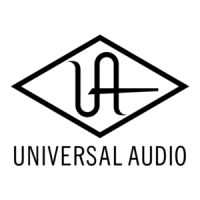Applications: Analog to Digital Conversion
__________________________________________________________
- 14 -
Using the 2192 for Analog To Digital Conversion
The 2192 enables incoming analog signals to be converted to digital, a process known as analog to
digital (A/D) conversion. The resulting digital signal is always in 24-bit format, is sampled at any of
six user-selectable rates (44.1, 48, 88.2, 96, 176.4, or 192kHz), and is sent to all rear panel digital
outputs (AES, SPDIF, and ADAT optical) simultaneously.
• The SPDIF interface transmits 24-bit audio at rates up to 192kHz.
• Audio digitized at sample rates 44.1khz, 48kHz, and 96kHz are transmitted over AES/EBU in
Single Wire mode, as specified by the setting of the Single/Dual switch. (see #8 on page 8)
• Audio digitized at sample rates above 96k are transmitted over AES/EBU in Dual Wire mode,
as specified by the setting of the Single/Dual switch. (see #8 on page 8)
• Audio digitized at sample rates above 48kHz is transmitted over ADAT optical with S–MUX
interleaving, as follows:
o At 88.2kHz and 96kHz, channels 1-4 are used for stereo audio.
o At 176.4kHz and 192kHz, all 8 channels are used for stereo audio.
When the Analog Outputs DAC Source Select knob (see #6 on page 7) is set to ADC, the signals at
the analog outs are the analog input signals after they have passed through both the A/D and D/A
converters, enabling “true confidence” analog monitoring of the digitized signal.
A/D conversion can be performed while the 2192 is using its internal clock, or when it is slaved to an
external clock. Each operation is detailed on the following pages.

